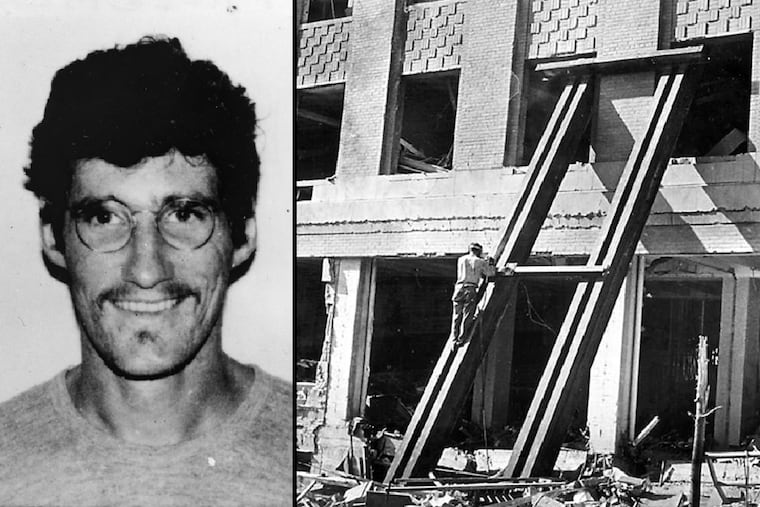50 years on the lam for a Delco ‘60s radical | Will Bunch Newsletter
Leo Burt, the last ‘60s fugitive, is still on the run ... if he’s still alive.

Summertime, and the living is … definitely not easy. Well, maybe for me, since I’m finally taking a couple of vacation days. That’s why I’m sharing this “golden oldie” piece from a few years back, super-relevant again in 2020. Did someone forward you this email? Sign up to receive this newsletter weekly, at inquirer.com/bunch.
History special: Leo Burt, the last ‘60s fugitive, is still on the run … if he’s still alive
This month marks the 50th anniversary of an event that was in many ways the last eruption of 1960s’-style radicalism — the August 24, 1970 bombing of an Army math research center at the University of Wisconsin that, unintentionally, killed a young researcher named Robert Fassnacht.
It also marked the last day in public for a Havertown rower and Monsignor Bonner grad turned campus journalist named Leo Burt, who disappeared shortly before he was indicted for the bombing along with three others. Reported sightings of Burt largely ended in the 1970s, and no one — including the FBI — seems to know if Burt is dead or alive … or where he is. I wrote an in-depth story about Burt on the 40th anniversary in 2010, and little has changed. Here’s an excerpt, with updated time references in brackets:
[In the late 2000s], Donald X. Burt was at home in an exurban community west of Philadelphia, when the phone rang. The FBI was calling again, as they had done so many times over the last 40 years.
This time, Burt says, they wanted something new: a sample of his DNA. Burt, a native of Havertown, and now a truck driver, refused. But he’s convinced that the feds were hoping to gather evidence to prove that his notorious brother — Leo Frederick Burt, the last remaining anti-war radical from the 1960s and early 1970s on the FBI’s fugitive list — is now dead.
That tip must not have panned out — just like hundreds of other tips that have fizzled over the last four decades. The feds are still seeking the former altar boy from St. Denis in Havertown, Schuylkill rowing jock and 1966 graduate of Monsignor Bonner High School, in Drexel Hill.
[This] month, it will be [50] years since Leo Burt dropped out of sight, in his rearview mirror the image of a massive mushroom cloud, the result of a car bomb that tore into a University of Wisconsin campus building. The bomb was aimed at an Army mathematics center — but, instead, it killed a physics researcher pulling an all-nighter.
That was Aug. 24, 1970. In those first frantic days on the lam, Burt and one of the other bombers narrowly missed being captured a couple of times, but he has not been heard from since a written manifesto attributed to him was published in 1972.
The FBI is still offering a $150,000 reward for information leading to his arrest.
If Burt is still alive, he is [72] years old. The Vietnam War — which played the central role in converting the Wisconsin student from mild-mannered rower into a radical journalist and then a revolutionary — ended in 1975. The three others who bombed UW’s Sterling Hall were arrested, served short jail terms and started new lives. Eventually, every notorious left-wing radical who went underground after the tumultuous end of the 1960s was caught or surrendered.
Except for Leo Frederick Burt.
The news [in 2010] that one of Burt’s three 1970 coconspirators, Dwight Armstrong, had died from lung cancer only increased the sense among the handful of people still following the case that the mystery of what happened to Burt may never be solved. That would leave so many other questions unanswered.
How does a studious, bespectacled athlete from Philadelphia’s middle-class suburbs, who took part in Marine ROTC training, end up behind America’s worst car bombing until the World Trade Center attack in 1993? All these years later, Burt’s family and friends still grapple to explain it.
Was the Bonner grad really a campus radical? Or was he something completely different — a counter-revolutionary or even an agent provocateur working undercover for the government?
Want to read the rest of the story? You can find it here.
Yo, do this
Here’s a confession: I haven’t been indulging in pop culture very much the last couple of weeks, and you can blame the return of sports — especially soccer. England’s Premier League has come and gone, but the MLS Is Back Cup summer tournament is kind of like an American World Cup. Except unlike the last World Cup in 2018, my team — the Philadelphia Union — is in it, and doing well. They play Wednesday night in the semifinals, hopefully en route to their first trophy in their decade-long existence. Breakout star Brenden Aaronson, just 19 and hailing from Medford in South Jersey, has been called the Ben Simmons of soccer, a great playmaker still working on his shot. If the Union keep winning, maybe they’ll even get a mention on WIP sports radio. (But probably not.)
No group in modern American music has had a stranger career path than The Chicks, the three-woman outfit from Texas (who dropped “Dixie” from their name in this year of Black Lives Matter). They make Grammy-worthy country music yet have been all but rejected by most of the country community for their liberal political statements — while embraced by newer fans who couldn’t Nashville on a map or their radio dial. Their first new album in 14 years — Gaslighter, a word people weren’t using in 2006 — couldn’t be more timely, with the call to arms “March March,” and lead singer Natalie Maines bringing her power-pop blowtorch to her divorce in songs like the title track.